Advertisements
Advertisements
Questions
Describe with the help of a neat circuit diagram how you will determine the internal resistance of a cell by using a potentiometer. Derive the necessary formula.
Explain the use of a potentiometer to determine the internal resistance of a cell.
Solution
- The experimental setup for this method consists of a potentiometer wire AB connected in series with a cell of emf ε, the key K1, and rheostat as shown in the figure.

- Terminal A is at a higher potential than Terminal B. A cell of emf ε1 whose internal resistance r is to be determined is connected to the potentiometer wire through a galvanometer G and the jockey J.
- A resistance box R is connected across cell ε1 through the key K2. The key K1 is closed and K2 is open.
- The circuit now consists of cell ε, cell ε1, and the potentiometer wire. The null point is then obtained.
- Let l1 be the length of the potentiometer wire between the null point and point A. This length corresponds to emf ε1.
∴ ε1 = kl1 ….(1)
where K is the potential gradient of the potentiometer wire which is constant. - Now both the keys K1 and K2 are closed so that the circuit consists of cell ε, cell ε1, the resistance box, the galvanometer, and the jockey. Some resistance R is selected from the resistance box and a null point is obtained.
- The length of the wire l2 between the null point and point A is measured. This corresponds to the voltage between the null point and point A.
∴ V = kl2 ….(2)
Dividing equation (1) by equation (2),
∴ `"ε"_1/"V" = ("k""l"_1)/("k""l"_2) = "l"_1/"l"_2` .....(3) - Consider the loop PQSTP,
ε1 = IR + Ir and V = IR
∴ `"ε"_1/"V" = ("IR" + "Ir")/("IR") = ("R" + "r")/"R" = "l"_1/"l"_2` ....….[From equation (3)]
⇒ r = R`("l"_1/"l"_2 - 1)`
The above equation is used to determine the internal resistance of the cell.
APPEARS IN
RELATED QUESTIONS
A potentiometer wire has resistance of per unit length of 0.1 Ω/m. A cell of e.m.f. 1.5 V balances against a 300 cm length of the wire. Find the current in the potentiometer wire.
State the principle of working of a potentiometer.
In a potentiometer experiment, balancing length is found to be 120 cm for a cell E1 of emf 2V. What will be the balancing length for another cell E2 of emf 1.5V? (No other changes are made in the experiment.)
In the given circuit, with steady current, calculate the potential drop across the capacitor and the charge stored in it.

In the given circuit in the steady state, obtain the expressions for (a) the potential drop (b) the charge and (c) the energy stored in the capacitor, C.

A potentiometer wire of length 1 m has a resistance of 5 Ω. It is connected to a 8 V battery in series with a resistance of 15 Ω. Determine the emf of the primary cell which gives a balance point at 60 cm.
State the working principle of a potentiometer. With the help of the circuit diagram, explain how a potentiometer is used to compare the emf's of two primary cells. Obtain the required expression used for comparing the emfs.
Write two possible causes for one sided deflection in a potentiometer experiment.
Write the principle of working of a potentiometer. Describe briefly, with the help of a circuit diagram, how a potentiometer is used to determine the internal resistance of a given cell.
Would you prefer a voltmeter or a potentiometer to measure the emf of a battery?
The potentiometer wire AB shown in the figure is 50 cm long. When AD = 30 cm, no deflection occurs in the galvanometer. Find R.
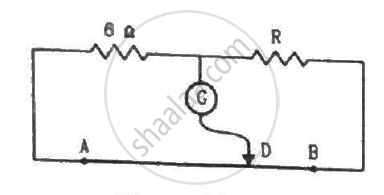
Define potential gradient of the potentiometer wire.
How is potential gradient measured? Explain.
What are the disadvantages of a potentiometer?
When two cells of emf's E1 and E2 are connected in series so as to assist each other, their balancing length on a potentiometer wire is found to be 2.7 m. When the cells are connected in series so as to oppose each other, the balancing length is found to be 0.3 m. Compare the emf's of the two cells.
The emf of a cell is balanced by a length of 120 cm of a potentiometer wire. When the cell is shunted by a resistance of 10 Ω, the balancing length is reduced by 20 cm. Find the internal resistance of the cell.
The SI unit of the potential gradient is ______
When the null point is obtained in the potentiometer, the current is drawn from the ______
What is the SI unit of potential gradient?
The emf of a standard cell is 1.5V and is balanced by a length of 300 cm of a potentiometer with a 10 m long wire. Find the percentage error in a voltmeter that balances at 350 cm when its reading is 1.8 V.
Which of the following instruments is not a direct reading instrument?
Two cells having unknown emfs E1 and E2 (E1 > E2) are connected in potentiometer circuit, so as to assist each other. The null point obtained is at 490 cm from the higher potential end. When cell E2 is connected, so as to oppose cell E1, the null point is obtained at 90 cm from the same end. The ratio of the emfs of two cells `("E"_1/"E"_2)` is ______.
A 10 m long wire of resistance 20 Q is connected in series with a battery of emf 3 V and a resistance of 10 Ω. The potential gradient along the wire in V/m is ________.
In a potentiometer experiment, when the galvanometer shows no deflection, then no current flows through ____________.
A potentiometer is an ideal device for measuring potential difference because ______.
Select the WRONG statement:
A potentiometer wire has length L For given cell of emf E, the balancing length is `"L"/3` from 3 the positive end of the wire. If the length of the potentiometer wire is increased by 50%, then for the same cell, the balance point is obtained at length.
Which of the following is true for a potentiometer?
When two cells of e.m.f 1.5 V and 1.1 V connected in series are balanced on a potentiometer, the balancing length is 260 cm. The balancing length, when they are connected in opposition is (in cm) ____________.
In the potentiometer experiment, the balancing length with cell E1 of unknown e.m.f. is ℓ1 cm. By shunting the cell E1 with resistance 'R' which is equal to internal resistance (r) of the cell E1, the balancing length ℓ2 is ______
A potentiometer is used to measure the potential difference between A and B, the null point is obtained at 0.9 m. Now the potential difference between A and C is measured, the null point is obtained at 0.3 m. The ratio `E_2/E_1` is (E1 > E2) ______

The current drawn from the battery in the given network is ______
(Internal resistance of the battery is neglected)

In the experiment to determine the internal resistance of a cell (E1) using a potentiometer, the resistance drawn from the resistance box is 'R'. The potential difference across the balancing length of the wire is equal to the terminal potential difference (V) of the cell. The value of internal resistance (r) of the cell is ______
A student connected the circuit as shown in the figure to determine the internal resistance of a cell E1 by potentiometer (E > E1). He is unable to obtain the null point because ______.
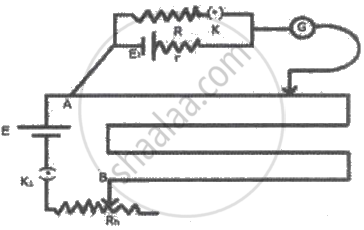
A potentiometer wire is 4 m long and a potential difference of 3 V is maintained between the ends. The e.m.f. of the cell which balances against a length of 100 cm of the potentiometer wire is ______
A potentiometer wire of length 'L' and a resistance 'r' are connected in series with a battery of E.M.F. 'E0' and a resistance 'r1'. A cell of unknown E.M.F, 'E' is balanced at a length 'ℓ' of the potentiometer wire. The unknown E.M.F. E is given by ______
In the potentiometer experiment, the balancing length with a cell E1 of unknown e.m.f. is 'ℓ1' cm. By shunting the cell with resistance R Ω, the balancing length becomes `ℓ_1/2` cm, the internal resistance (r) of a cell is ______
In a potentiometer experiment, for measuring internal resistance of a cell, the balance point has been obtained on the fourth wire. The balance point can be shifted to fifth wire by ______.
In the experiment of potentiometer, at balance point, there is no current in the ______.
The best instrument for accurate measurement of EMF of a cell is ____________.
The conductivity of super - conductor is
What is the current I in the circuit as show in fig.
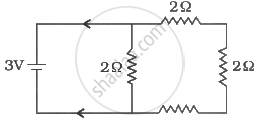
The instrument among the following which measures the e.m.f of a cell most accurately is ______
In a potentiometer circuit a cell of EMF 1.5 V gives balance point at 36 cm length of wire. If another cell of EMF 2.5 V replaces the first cell, then at what length of the wire, the balance point occurs?
AB is a potentiometer wire (Figure). If the value of R is increased, in which direction will the balance point J shift?
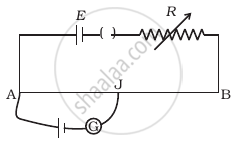
For the circuit shown, with R1 = 1.0 Ω, R2 = 2.0 Ω, E1 = 2 V, and E2 = E3 = 4 V, the potential difference between the points 'a' and 'b' is approximately (in V) ______.
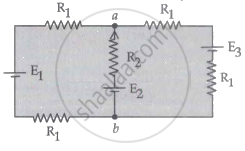
Potential difference between the points A and B in the circuit shown is 16 V, then potential difference across 2Ω resistor is ______ V. volt. (VA > VB)

Two cells of same emf but different internal resistances r1 and r2 are connected in series with a resistance R. The value of resistance R, for which the potential difference across second cell is zero, is ______.
A potentiometer wire AB having length L and resistance 12r is joined to a cell D of emf ε and internal resistance r. A cell C having emt `ε/2` and internal resistance 3r is connected. The length AJ at which the galvanometer as shown in the figure shows no deflection is ______.
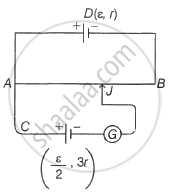
What is the effect of decreasing the current through the potentiometer on the null point?
A particle carrying 8 electron charges starts from rest and is accelerated through a potential difference of 9000 V. Calculate the KE acquired by it in keV.
What should be the diameter of a soap bubble such that the excess pressure inside it is 51.2 Pa? [Surface tension of soap solution = 3.2 × 10−2 N/m]
State dimension of potential gradient.
